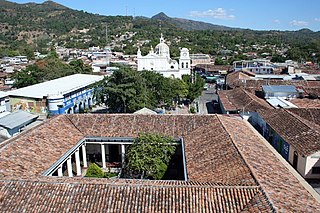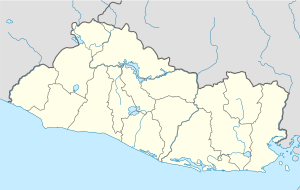
Chalatenango is a department of El Salvador, located in the northwest of the country. The capital is the city of Chalatenango. The Chalatenango Department encompasses 2,017 km² and contains more than 204,000 inhabitants. Las Matras Archaeological Ruins contains the relics of prehistoric populations and caves in which rock writing is found. The "5 de Noviembre" Hydroelectric Dam is found in Chalatenango Department, near the border with Cabañas. The highest point in the country, El Pital with an elevation of 2730 m, is also located in Chalatenango Department.

Ahuachapán is a city, and municipality, and the capital of the Ahuachapán Department in western El Salvador. The municipality, including the city, covers an area of 244.84 km² and as of 2007 has a population of 110,511 people. Situated near the Guatemalan border, it is the westernmost city in the country and is the center of an agricultural region producing primarily coffee.

Salvadoran cuisine is a style of cooking derived from the nation of El Salvador. The indigenous foods consist of a mix of Native American cuisine from groups such as the Lenca, Pipil, Maya Poqomam, Maya Chʼortiʼ, Alaguilac, Mixe, and Cacaopera peoples. Many of the dishes are made with maize (corn). There is also heavy use of pork and seafood. Eurasian ingredients were incorporated after the Spanish conquest.

Santa Rita is a municipality in the Chalatenango department of El Salvador and is one of the largest municipalities of Chalatenango. It has a shoreline on Lake Suchitlán and is bordered by the municipalities of Comalapa, Dulce Nombre de María, Concepción Quetzaltepeque, El Paraíso, and San Rafael.

Arcatao is a municipality and small town in the Department of Chalatenango, El Salvador.

Chalatenango is a town and municipality in the Chalatenango department of El Salvador. It is the capital of the department. As of 1 May 2021, Alfredo Hernández of Nuevas Ideas (NI) is the municipality's mayor.

Dulce Nombre de María is a town and municipality in the Chalatenango Department of El Salvador. It is located 72 kilometers (45 mi) from San Salvador, the capital of El Salvador.

La Palma is a municipality in the Chalatenango department of El Salvador. The municipality, located in a mountainous area of the country, covers an area of 135.60 km2 and as of 2006 had an approximate population of 24,000.
Las Vueltas is a municipality in the Chalatenango Department in the north of El Salvador. The municipality is bordered to the north by Ojos de Agua, to the east by Las Flores, to the south by Chalatenango, and to the northeast by Concepción Quezaltepeque. The territory covers 36.83 km² and the population was, as of 2005, of 2,101 inhabitants. For its administration, the municipality is divided into six cantones and 35 caseríos.

Suchitoto is a municipality in the Department of Cuscatlán, El Salvador that has seen continuous human habitation long before Spanish colonization. Within its municipal territory, Suchitoto holds the site of the original founding of the Villa of San Salvador in 1528 that existed for a short time before the site was abandoned. In more recent times, the municipality has prospered even after the severe effects of civil war in El Salvador that lasted between 1980 - 1992 and saw the population of Suchitoto decrease from 34,101 people in 1971 to 13,850 by 1992. It has become an important tourist destination partly due to its well conserved colonial architecture and cobblestone roads that provide a sense of Spanish colonial living. This rise in tourism has attracted service sector businesses to open up in the small city including hostels, restaurants, and picturesque cafes. As a result of tourism, many arts and cultural spaces have opened up in Suchitoto that are also providing positive alternative opportunities for youth in the community. According to the 2007 Official Census, the small city has a population of 24,786 people with 7,654 people living in the urban area and 17,132 people living in the rural communities.
San Isidro is a municipality in the Cabañas department of El Salvador, roughly 70 kilometres (43 mi) northeast of San Salvador.

Chalatenango is a municipality located in the Department of Chalatenango, in the north of El Salvador.

San Jose Ojos de Agua is a municipality is located in the department of Chalatenango in the North of El Salvador
Concepción Quetzaltepeque is a municipality in the department of Chalatenango in the north of El Salvador. It is bordered to the north by Comalapa and La Laguna, to the east by Las Vueltas and Chalatenango, to the south by Chalatenango, and to the west by Santa Rita. The territorial extension of the municipality is 52.54 km2. In 2005 the population was 6,734 inhabitants. The municipality's administration is divided into 6 cantons and 14 caserío.
El Carrizal is a municipality located in the department of Chalatenango in the North of El Salvador.
La Laguna is a municipality in the Chalatenango department of El Salvador.
The Cerrón Grande Hydroelectric Dam spans the Lempa River 78 km (48 mi) north of San Salvador in the municipalities of Potonico, (Chalatenango) and Jutiapa (Cabañas) in El Salvador.
Club Deportivo Atlético Comalapa is a Salvadoran professional football club based in Chalatenango, El Salvador.

Canton El Tablón belonged to the Municipality of Suchitoto, Cuscatlan, El Salvador. El Tablón was one of many cantons in the surrounding area that was flooded as a result of the Cerron Grande Hydroelectric Dam built in El Salvador between 1972-1976 that created the artificial Lake Suchitlán. According to former residents of El Tablon, the area was divided up into four main wikt:caseríos or hamlets, Caserio La Hacienda Vieja, Caserio Los Figueroas, Caserio Valle El Tablón, and Caserio Los Palitos. It is unclear where the name El Tablon originated from, but according to local historians, an aldea or village/hamlet of El Tablón existed prior to 1860 that was formed through a municipal ejido. An ejido was commonly owned municipal land granted by the Spanish Crown to governing bodies in the Spanish Empire. These lands were considered vacant or unused land in some cases belonging to existing indigenous communities.












